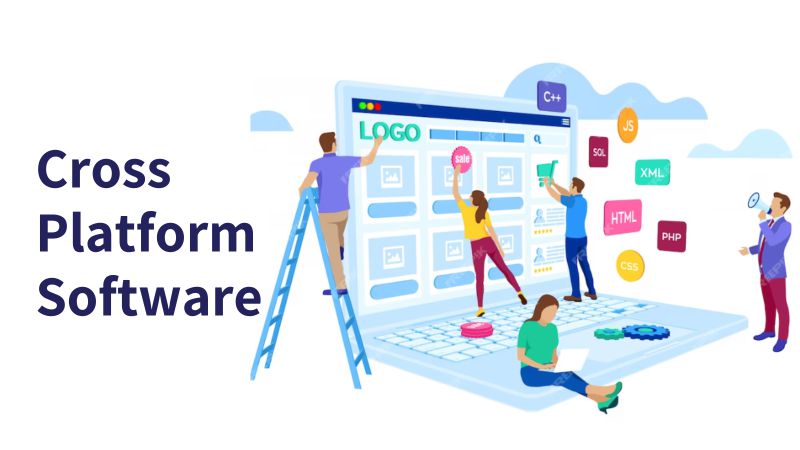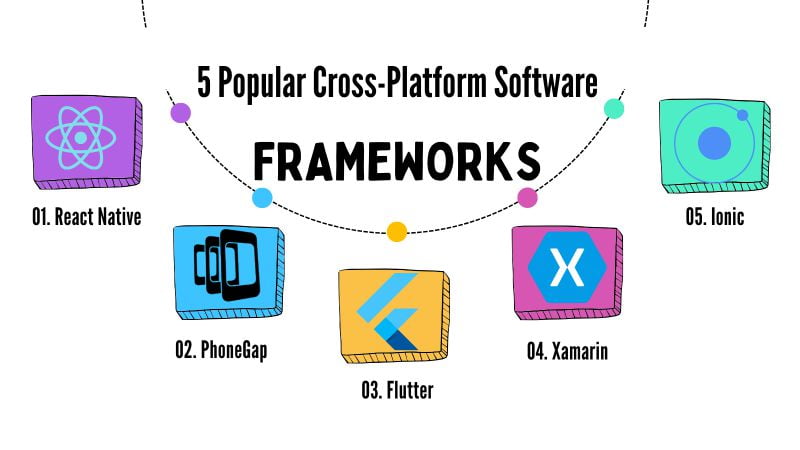Software that operates on different devices like computers, smartphones, and tablets is called cross-platform software. Cross platform software is growing in importance for businesses today as they seek methods to connect with more customers.
Smartphone sales have passed computer sales since 2011. This definitely changes how we use technology now. People use mobile devices more. Cross-platform app making lets software work on different devices. This helps software reach more users no matter what device they have.
Cross-platform software can help businesses in important ways. It can lower costs to make apps. It lets more people use apps. It’s also easier to fix problems. This article will teach us what cross-platform software is and things to know about it.

What is cross-platform software?
Software that operates across multiple devices simplifies creating programs for varied users. Code for this cross-platform software requires little adjustment between operating systems, letting programmers build applications reachable by more people through a single code foundation. This streamlines development by cutting the time and expenses involved.
An operating system like Windows, Mac OS, iOS, or Android is called a platform. Software made for multiple platforms can reach more people. It can work on phones, tablets, computers, and other internet-linked devices. Having software for different platforms opens more opportunities.
What is cross platform language?
A programming language lets programmers write code one time and then use it on many platforms, like different operating systems or devices, with few changes needed. This language allows writing once and running everywhere.
What are the benefits of cross-platform software?

Code Reusability
Writing code once that works on different devices is helpful. Developers can create one set of instructions and use it for Android, iOS, and Windows phones and tablets. This lets software makers spend less time writing similar code multiple times. A research group found that making apps this way can cut costs up to 60% compared to developing separately for each platform. The reason is programmers don’t repeat themselves typing the same directions for each type of device. They write code one time which makes creating apps faster and easier.
Expand user base
Cross-platform apps link businesses and users across different devices. They break down barriers between platforms, letting developers build an audience much larger than a single device could reach. Developers gain new potential customers they otherwise might miss. This wider reach can boost a company’s income and market share, as proven by apps like Facebook and Instagram available everywhere. A study from Statista says the worldwide market for multi-platform app development may hit a huge 6.7 billion by 2033. Such growth shows the opportunity cross-platform development presents.
Reduced development time and costs
With cross-platform development, businesses can streamline their development process and minimize maintenance costs. One group of developers can handle all versions of the app instead of needing separate teams for each type of device. This saves time and money while also helping the developers work together better. Plus, using the same starting code and shared tools means no extra libraries or frameworks specific to each device. That further cuts down on difficulties and expenses in development.
Consistent UI/UX
Cross-platform frameworks focus on matching user experiences regardless of device, ensuring interactions feel similar. This consistency builds trust in the brand by making the app familiar, motivating users to use it more. A study showed matching designs can raise satisfaction by up to 22% and conversions by up to 80%, underlining its importance for business achievement.
Simple cloud integration
Businesses can use cross-platform software to easily connect with cloud services. This lets companies use the cloud’s strength for flexibility and features. Access to data storage, analysis, and crucial services allows businesses to adjust to more users and shifting market needs. Also, a single source code simplifies adding extensions and plugins. That further improves what the app can do and its worth.
The future bright
More companies and big players are choosing to make apps that work on different devices. This shows that cross-platform making will be important later. Groups that make programs try to make frameworks do more and be easier to change. That means companies will keep earning money if they use this strong way to code. Cross-platform making has lots of good parts. It will likely shape what software looks like in the future. It helps businesses reach more people, make work better, and do better overall.
What limitations does cross-platform software have?
Cross-platform apps let programs work across devices. This saves money and time making apps. It lets more people use the software. But making cross-platform apps has limits too.
Compatibility issues
The various platforms each have their own standards, features, and APIs. This can cause app errors, crashes, freezes, or uneven performance. Also, some cross-platform tools may not support native features such as camera, GPS, push alerts, and more. This forces developers to use third-party plugins, which can introduce additional complexity and risk.
Application performance
The use of interpreters or middleware can slow down response time, battery life, and the user experience. Additionally, cross-platform software often does not fully leverage the power of native platforms or directly access hardware resources. This can lead to lower graphics quality, animation effects, or user interface than native applications.
Application feature limitations
Compared to native development, cross-platform often lacks advanced or platform-specific features such as 3D graphics, AR, ML, etc. Additionally, developers may have difficulty implementing these features due to lack of resources or community support.
Complexity in the development and maintenance process
Learning new languages and frameworks can be time-consuming and challenging. Additionally, developers need to understand the standards and features of each platform in order to ensure the application works correctly. Furthermore, while cross-platform development can save costs initially, maintaining different versions for multiple platforms over time can also be expensive.
5 Popular Cross-Platform Software Frameworks

1. React Native
- Programming language: JavaScript
- Pros: Builds high-performance UI resembling native applications, used by giants like Facebook and Instagram
- Cons: Requires knowledge of ReactJS, may have performance issues with complex apps
2. Flutter
- Programming language: Dart
- Pros: Provides highly customizable widgets for responsive UI, hot-reload feature for instant code changes, good performance
- Cons: Dart is a new language, user community and documentation may be more limited than React Native
3. Xamarin
- Programming language: C#
- Pros: Uses a shared codebase for iOS, Android, and Windows, enables creating native UIs and accessing platform-specific APIs
- Cons: C# is not as popular in web development, requires knowledge of both C# and mobile platforms
4. Ionic
- Programming language: HTML, CSS, JavaScript
- Pros: Open-source, provides a rich set of pre-built UI components and plugins for native-like functionality, easy to integrate with web
- Cons: Performance may be lower than other frameworks, UI and user experience may not be fully native
5. PhoneGap
- Programming language: Web technologies (HTML, CSS, JavaScript)
- Pros: Open-source, easy to learn and use, provides a cloud-based build app service
- Cons: Worst performance in the list, heavily relies on third-party plugins, UI and user experience may be limited
Whether choosing React Native, Flutter, Ionic, PhoneGap, or Xamarin depends on several factors. For complex apps requiring high performance, React Native and Flutter offer possibilities as both enable building for multiple platforms simultaneously. Ionic and PhoneGap suit simpler apps where rapid development is key. Xamarin proves ideal when needing true native apps across devices but developing them together.
Conclusion
To summarize, cross platform softawre has become an important solution in app development. This makes building and updating apps for multiple platforms easier. Some sentences in an explanation may be longer or more complex, while others are shorter. Overall, the information is presented clearly at a mid-school level without exaggeration or hard-to-understand terminology.
Businesses and developers now have more options because programs can work on different devices. This flexibility and lower costs let businesses try new ideas. Still, which tools to use depends on what the project needs and its technical details.
Table Of Content


